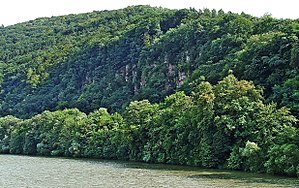Neckar Valley I-Little Odenwald
|
Landscape protection area "Neckartal I-Kleiner Odenwald"
|
||
| location | Bammental , Epfenbach , Neckargemünd , Reichartshausen , Schönbrunn , Wiesenbach and Lobbach in the Rhein-Neckar district in Baden-Württemberg , Germany | |
| surface | 63.25 km² | |
| Identifier | 2.26.045 | |
| WDPA ID | 323144 | |
| Geographical location | 49 ° 28 ' N , 8 ° 35' E | |
|
|
||
| Setup date | July 12, 2002 | |
| administration | District Office Rhein-Neckar-Kreis | |
Neckartal I-Kleiner Odenwald is a protected landscape area in the Rhein-Neckar district in Baden-Württemberg .
Location and description
The approximately 6,325 hectare landscape protection area covers part of the Kleiner Odenwald between Neckargemünd and the Schönbrunn district of Allemühl and was created by ordinance of the Rhein-Neckar-Kreis district office on July 12, 2002. At the same time, the ordinance of the regional council of North Baden for the protection of parts of the landscape in the area of Mannbachtales dated October 25, 1957, the ordinance of the North Baden regional council for the protection of parts of the landscape in the city and district of Heidelberg and in the Mannheim district of December 12, 1953 (as far as it applied to the affected parts of the district of Neckargemünd) and the ordinance of the president of the state district Baden for the protection of parts of the landscape in the districts of Heidelberg and Mosbach from March 13, 1951, as far as it extended to the area of the Rhein-Neckar district, ceased to be in force.
The protected area belongs to the natural area 144- Buntsandstein-Odenwald within the natural spatial main unit 14- Odenwald, Spessart and Südrhön .
Protection purpose
According to the Protected Area Ordinance, the main protection purpose is the preservation and development of the river landscape of the Neckar , which is cut into the surrounding area, and the low mountain range of the Little Odenwald, which is rich in relief, in its beauty, diversity and character. Characteristic features of these landscapes are:
- the Neckar with its bank zones, narrow floodplains, valley flanks in an alternation of steep rebound and less inclined sliding slopes, deeply cut side valleys and blades as well as its abandoned loops (wall loop, flower line loop, mosquito hole loop), through the distinctive individual elevations such as the Hollmut, Dilsberg and Kirchberg have arisen;
- the plateaus of the Kleiner Odenwald, structured by a variety of surface shapes such as peaks, ridges, hollows, valleys and blades;
- closed forests on the valley slopes and plateaus with a varied forest-field border and semi-natural deciduous forests, which are defined by tiered forest edges;
- Block piles with special block pile vegetation on the slopes of the Neckar and its side valleys;
- unobstructed flowing water, accompanied by ravine forests or near-natural riparian vegetation made of riparian wood, reed beds, tall perennials and their narrow meadows in meadow use;
- Field corridors structured by meadows, fields, orchards, field trees, field hedges, bushes and individual trees in flat to slightly inclined positions in the area of the meander arches of the Neckar, its abandoned loops and on the plateaus of the Odenwald as well
- closed meadow areas on steeper valley slopes of the Neckar, its abandoned loops, the brooks as well as in damp hollows and on steep slopes of the Odenwald, interspersed with field trees, field hedges, orchards, bushes or individual trees; Terrain forms and small structures such as dry stone walls, stone bars, rock walls, embankments, creeks, ditches and ravines.
The protection purpose is also to ensure the high recreational value for the general public through the maintenance, development and improvement of the landscape components that determine the diversity, character and beauty of the landscape and site-appropriate land use forms, the essential preservation of the forest field distribution and the maintenance or restoration of the free accessibility of the Landscape as well as the sustainable safeguarding of the efficiency of the natural balance and the usability of the natural assets through the maintenance and restoration of the natural profitability of the soil and the protection against erosion as well as through the maintenance of areas with positive effects on the climate and the water balance.
The preservation and development of the habitats and communities of the native animal and plant species, especially in the corridors divided by field hedges, field trees, bushes, individual trees, orchards, stone bars, dry stone walls and embankments, in the closed forest areas with old wood stocks, deciduous forests, ravine and log forests , in the old quarries and in the waters and wetlands are also worthy of protection.
See also
Web links
- Profile of the landscape protection area in the protected area directory of the LUBW



